Barbados - where to see wildlife, wildflowers and fungi
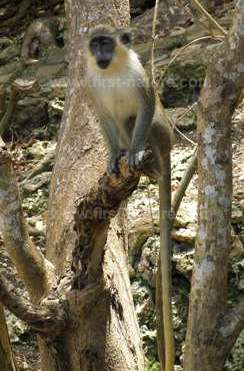
Above: the Barbados Green Monkey
The wildlife, wildflowers, fungi and beautiful coastline of Barbados are very special. In Barbados the birds sing all day, and at night the miniscule (in size but not voice) Whistling Frogs take over the musical entertainment with the conductor handing over the baton at approximately 7pm, which is also when the bats begin their crazy nocturnal airborne aerobics. Funny, then, that the island is frequently dismissed by those bent on the pursuit of wildlife and wildflowers on their holidays. It's true that much of the natural environment has been converted to agricultural land or for building luxury houses, hotels and other holiday developments. What do you expect from an island just 14 miles wide and 21 miles long, with a population of 270,000 and the additional pressure of being synonymous with our dreams of tropical luxury? Despite this we enjoyed much in the way of wildlife, including mammals, birds and butterflies as well as lovely wildflowers including wild orchids during our stay.
Another major plus for both residents and visitors, is that Barbados lies just outside the main zone for tropical storms in the region.
We quickly discovered that the way to see many of the wildflowers, butterflies and birds of Barbados is to head for the various excellent gardens and reserves, with frequent stops along the roadsides for a bit of judicious crawling around in the undergrowth, of course. (This is a safer pastime in Barbados than in many countries, owing to the imported Mongoose having done away with much of the snake population.)
Barbados, the most easterly of the Lesser Antillean islands, is composed of limestone coral. Because it is so highly populated there is huge pressure on the island and its resources, both on and offshore. The interior of the island is largely adapted to the production of sugar cane and bananas, with other food crops being grown in between.
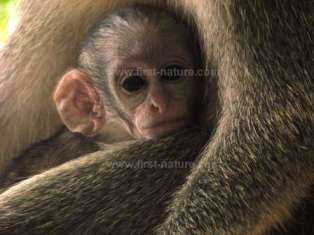
Above: a baby monkey is nursed by its mother
The government of Barbados goes to great lengths to protect the natural environment, to ensure that the drinking water on the island is clean and that damage to the 90 kilometres of precious offshore coral reefs is minimised. Two protected marine parks have been established off the west coast of the island. Although there is no formal State protection for inland nature sites, there are some excellent gardens and other 'reserves' managed by the Barbados National Trust.
For those who enjoy beautiful tropical scenery the coasts of Barbados are hard to beat. The palm-fringed beaches set alongside the gentle ocean of the west coast are truly the stuff of holiday dreams. They are easily accessible, too, with many public paths through to the beaches clearly marked - unlike the Florida Keys where, it seems, every grain of sand is owned and carefully guarded by the accommodation providers!
For a small charge you can hire a sun-lounger and beach umbrella and set up for the day. Food and drink are never far away, and so there is no need to pack up the family and decamp by car from your patch of paradise in order to get food.
The people of Barbados want you to enjoy your time here. Whether yours is a wildlife watching holiday in search of birds, bats, flowers or fungi, or simply a chance to soak up some sunshine, the local people seem keen to to go out of their way to ensure that you are not disappointed.
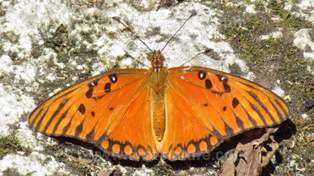
Above: the Silver-spotted Flambeau Butterfly
If wilder places are more appealing, Barbados can offer that, too. A short drive across the island to the eastern side reveals a magnificent and dramatic coastline very unlike that on the west. The Atlantic Ocean thunders in against rocky cliffs, and the warm wind whips the sand up along vast stretches of golden beaches. This sea, with its strong, swirling currents, is not a place for swimming, but there are some lovely bays where you can relax on the beach and have a thoroughly enjoyable day lost in admiration for the beauty of the island. It's also a good place to see some of the wildflowers and other plants that live in this salty, inhospitable habitat. The pretty Seaside Bean (Canavalia rosea), with its racemes of pink and white flowers, is everywhere.
Above, L - R: Shak Shak, Crotalaria retusa, Seaside Bean, Canavalia rosea, Wild Cucumber, Coccina grandis
Along the roadsides look out for Wild Cucumber, Coccinia grandis, a native of Africa that is naturalised and rampant in Barbados; its green fruits eventually turn red from their tips. This plant, with its lovely white flowers, doesn't just scramble over roadside banks and trees; it will also take over abandoned buildings in a remarkably short period of time. Keeping the Wild Cucumber company is Shak Shak or Yellow Sweet Pea, Crotalaria retusa, another non-native (originally from Asia) that is perfectly at home in Barbados. You will find Shak Shak on roadsides and in acid grassland, where its bright yellow, erect racemes of flowers are hard to miss.
Above, L - R: Lion Head, Leonotis nepetifolia, Mexican Poppy, Argemone mexicana, Blue Vine, Clitoria ternetea
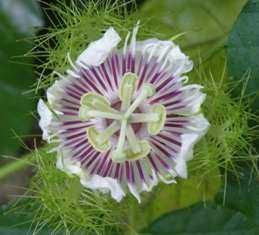
Above: Passiflora foetida with its fascinating tangle of bracts
Another couple of real beauties to look out for on the side of the road are Blue Vine, Clitoria ternatea, and a far less common and very exciting find, Love-in-a-Mist, Passiflora foetida. The latter, which despite its common name is a Passionflower and not a Nigella species, is very curious indeed. The flower bud is a tangled, softly hairy mass of green threads. These threads are extensions of the bracts that surround the flower, which has white petals with a purple and white corona. Even after flowering the plant remains attractive, and its bright orange berries can be made into a delicious sauce to accompany ice cream. Passiflora foetida is the larval foodplant of Agraulis vanillae, the Silver-spotted Flambeau or Gulf Fritillary butterfly, so look out for their gorgeous bright orange parents flitting about if you are lucky enough to find this flower.
Blue Vine is a flower so lovely that the gardening fraternity have cultivated a double form, although it is hard to imagine anything more gorgeous than the original. This bright purple-blue member of the Pea family (Fabaceae) is a common sight on waysides in Barbados, and it could even be a native. The throat of the flower is white and tinged with yellow - a lovely find.
Every stop on the side of the road on our journeys throughout the island yielded new and interesting finds, many of which were not visible from the car even though we were driving slowly. Stopping to get out and walk and look never fails!
Above, Left to Right - Barleria prionitis, French Cotton (Calatropis procera) and Garfield Bush (Stylosanthes hamata)
Two more of the beautiful and fascinating (although far less friendly) common roadside wildflowers in Barbados are Lion Head (Leonotis nepetifolia) and the bright yellow Mexican Poppy (Argemone mexicana), also called Yellow Hock locally. The latter is a member of the Poppy family (Papaveraceae) and is native to Tropical America; it is poisonous, so be sure to confine your activity to simply admiring the lovely flowers with their numerous stamens and bright red stigmas.
Although conspicuously upright, Lion Head is not an ideal plant to grasp as you steady yourself on a clamber up a roadside bank: the flower balls are very sharp and thorny. The plant is a native of Tropical Africa, but it has become naturalised in Barbados and is found mainly on abandoned farmland. The tubular shape of the orange flowers and the form of the leaves immediately identify it as a member of the Mint family (Lamiaceae).

Above: The Ground Orchid
Another amazing-looking plant which is clearly visible as you drive around the island, particularly numerous close to he coast, is French cotton (Calatropis procera). In Barbados this is a naturalised plant and a native of the Old World Tropics. At first glance it resembles a giant cabbage, but is actually a relative of Oleander which is well known to us from the Mediterranean Region. It is poisonous and so definitely not a cabbage substitute for Sunday lunch! Also close to the coast is the lovely Barleria prionitis, another Old World Tropics native, and Garfield Bush, a woody plant from the Pea (Fabaceae) family.
Three wild orchids grow in Barbados. Two of them are natives of Tropical America and the other is native to the Greater Caribbean region. The rarest of the three is Stenorrhynchos lanceolatus, a terrestrial species with bright orange, tube-shaped flowers that appear at the end of a stalk between 30 and 60cm in height.
The other terrestrial orchid on Barbados is the Ground Orchid, with its beautiful pinkish-purple flowers; common on rocky slopes and in acid grassland, it blooms from February to April. Some plants have peach-coloured flowers.
The third wild orchid found in Barbados is the Eyelash Orchid (Epidendrum ciliare), which grows on rocks and on tree trunks. The flowers are creamy-white and fragrant, and they have narrow petals and sepals. The lip is divided into three lobes, the outer two of which are delicately fringed, giving the plant its common name.
It is possible to see both the Ground Orchid and the Eyelash Orchid in Andromeda Gardens on the east coast, in Orchid World and Grenade Hall Forest (Eyelash Orchid only) - more details below.
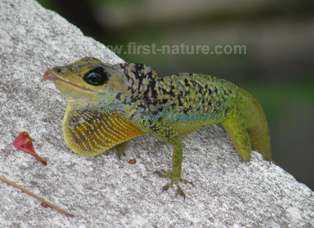
Above: one of the Barbados Green Lizards
Although Barbados is not a place for those who crave to see large numbers of endemic plants on their trips, it is nevertheless an excellent place to see native Antillean species. The lovely gardens and reserves also provide a chance to see many other wonderful tropical plants that thrive here and are only familiar to visitors from temperate climes as exotic house plants.
Creatures that simply cannot be ignored if you visit Barbados are the pint-sized Barbados Green Lizards. They are pretty much everywhere you go and are probably most obvious when scurrying up and down walls or tree trunks. They are wary little creatures since their soft skins and bodies make them ideal food for birds and mammals alike. They have a number of mechanisms for survival, however, and are able to distract prey by discarding their tails before making a hasty getaway, and also by changing colour. They, in turn, live on a diet of insects
Birds
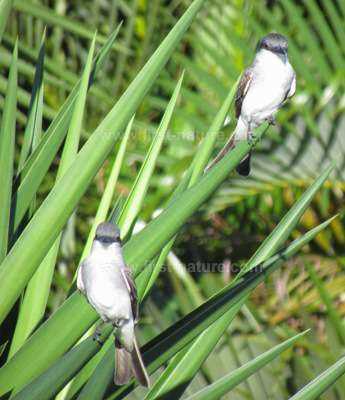
Above: the King Bird is a flycatcher
There are not many resident birds in Barbados, but what they lack in diversity they make up for in character! The most common, and referred to simply as the Blackbird on the island, is the Carib Grackle. The Grackles befriend the visitor almost everywhere and strut their stuff by leaning forward and making fans of their tails. The young birds accompany this strange movement with much fluttering of wings as they beg for food. Of the vast repertoire of calls of the Carib Grackle, the most common is a questioning 'do-you-want-one?'.
Also common around the gardens is the Grey Kingbird, known locally as the Rain Bird. It is a flycatcher but a very large one that closely resembles the Grey Shrike. Early mornings are a good time to observe King Birds as they perch on the tops of the trees in gardens or on other good vantage points (rooftops are ideal) and then swoop down upon their prey, which they catch in mid air.
Two nectar hunters, the Bananaquit and a hummingbird, the Antillean Crested Hummingbird, are also common garden visitors. In Barbados the Bananaquit is known as Yellowbreast, and it is really most attractive with its bright yellow undercarriage and conspicuous white stripes on either side of its head.
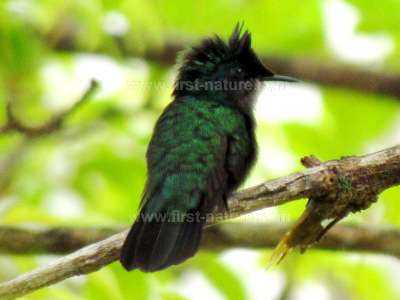
Above: The tiny Antillean Crested Hummingbird
The Antillean Crested Hummingbird is the smaller of the two hummingbirds found in Barbados and it is common, particularly in parks and gardens. The other, the Green-throated Carib, is a larger bird but we saw very little of it during our visit.
When visiting the countryside look out for Cattle Egrets, which are common throughout the island. Although they are recent arrivals (from the early 1950s) they have well and truly settled in as breeding birds, and large numbers of them roost in trees - we saw one tree with at least 100 birds resting in it.
Our most prized find, in a small swampy area, was a Green Heron (Butorides virescens) over which there is some taxonomical dispute, with some believing that the Caribbean and Central American birds are races distinct from each other. These birds are very rare now in Barbados, and we were extremely lucky to see this one which was standing completely still (a very obliging bird to photograph if you are lucky enough to see it!) and obviously targeting a small frog which was completely unaware of its presence. This clever bird is known to attract prey by dropping insects or other small morsels onto the surface of the water - a so-called 'tool-using' species.

Above: the Green Heron
Barbados has three different pigeons. One is about the same size as the ones we have in the UK although much more attractively coloured. They are a lovely reddish shade of light brown with pretty neck markings which include an irridescent patch on either side which can glow purple, blue or green in the sunshine. The second is tiny by comparison, about the same size as a King Bird, and very similar in colouring to the one described above. The third and largest of the three is a very different kettle of fish. It is much larger than the other two, considerably darker in overall colouring, and is frequently seen perching in the tops of trees especially early in the morning or in the late afternoon. This bird is called the Scaly-necked Pigeon and the reason is obvious from the rows of feathers which look exactly like scales when caught in the sun. It also has bright orange eye colourings - a most distinctive and rather fierce-looking bird.

Above: the Scaly-naped Pigeon
One of the strangest things about the birdlife of Barbados is the apparent absence of sea birds. There are no gulls screaming overhead to disturb the peace of the beaches, but there up to a dozen species of terns recorded for the island, and seeing them is simply a case of being in the right place at the right time. Shore birds are seldom seen, either, but we spotted several groups of delightful small Sanderlings scurrying along the beach and dodging the waves.
The coast does have one ace up its sleeve, however, and that is the Magnificent Frigatebird. This is a seabird of epic proportions having a wingspan of just over two metres (7ft), and we were lucky enough to see quite a number of them at close quarters during our stay. Other than the Common Swift no other bird spends as long at sea as the Magnificent Frigatebird. It is a creature of the tropics, and when they do make land in the breeding season, they nest in coastal trees.
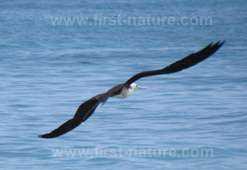
The Magnificent Frigatebird: above female; below, male
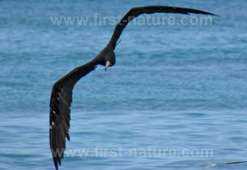
Although known to stray as far as Europe, the countries they mainly inhabit are in the tropical Atlantic region, and they breed in Florida, the Caribbean and Cape Verde Islands. It also breeds along the Pacific coast of the Americas from Mexico to Ecuador including the Galapagos Islands. They are alerted to food by observing other birds feeding which they then pursue forcing them to disgorge their food. For such massive birds they are amazingly agile but never land on the water, taking fish from the surface while in flight.
Barbados is famous for two mammals, and both are imports. Firstly, there is the Mongoose, which was brought to the island to eradicate the snakes. It seems to have done a good job, and we have not spotted any snakes during our visit despite much 'off piste' scrambling about, and the second is the Barbados Green Monkey.
Mongoose are easy to spot on the small back roads where there are sandy banks in which it burrows, but they are difficult to photograph as they race across the road in front of unsuspecting drivers. One of the best places to see them is out at Bath Beach on the East Coast where there is a massive population of Mongoose living in the sandy soil immediately behind the beach.The grass is kept short for visitors to picnic, and so the Mongoose are more easily spotted as they run back and forth between the small river gully close to the car park and the lush growth at the edge of the 'green'.
The lovely Barbados Green Monkeys are very shy, and so although they are both common and clearly visible they are difficult to photograph. One of the best places to see them up close is to visit the Barbados Wildlife Reserve, where they are far less afraid of the visitors and much easier to take pictures of - more details below.

Above: A Sanderling - they are common on the beaches
Bath Beach is also one of the places where the sea turtles come ashore to lay their eggs. The four kinds of sea turtles that occur in Barbados are the Green Turtle (Chelonia mydas), the Hawksbill Turtle (Eretmochelys imbricata), the Leatherback Turtle (Dermochelys coriacea) and the Loggerhead turtle (Caretta caretta). The turtle nesting times are generally between May and October, peaking in June and July. Once the eggs are laid they incubate in the sand for approximately 60 days before the hatchlings break free from the eggshells and make their way to the sea. There is no hard and fast rule for the timing of nesting for the turtles in Barbados, and nesting has been observed during every month of the year.
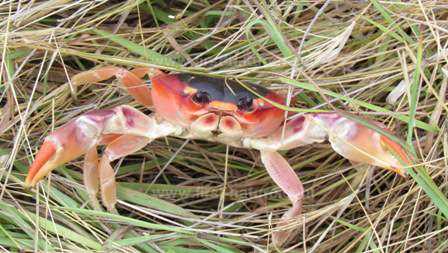
Above: the Caribbean Land Crab
Although the Mongoose has eradicated most (if not all) of the snake population in Barbados there are still a number of good reasons to wear stout shoes if you are planning on a bit of walking away from the beaches and well-trodden paths: numerous ants are one, but another is the curious Caribbean Land Crab (Gecarcinus ruricola). This feisty little creature comes in four colour variations - black, green, yellow and red - and being far inland is no guarantee that you won't get a vicious nip from these creatures, which have been recorded many kilometres from the shore and at surprising altitudes.
The eggs of the Caribbean Land Crab are laid at sea, and when they hatch and return to the land the small crabs spend some time living in the burrows of older crabs and sharing their food before setting up home on their own. Adaptations to living on land rather than in water mean that these crabs conserve moisture by being generally nocturnal; they also have the ability to reabsorb their urine.
Great places to see the wildlife of Barbados - the plants, birds, butterflies and animals
Entry to the various parks, gardens and reserves in Barbados doesn't come cheap (around Bajan $25 per adult) but they are truly worth the money.
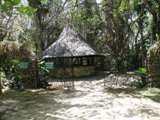
Barbados Wildlife Reserve
This is much more than a reserve to see wildlife; it is also a place to learn about some of the history of Barbados and about its forest ecosystem. The restored Grenade Hall Signal Station tells us how communications were managed on the island before the introduction of telephones. Manned in the 19th Century by the Royal Artillery, messages were transmitted to Bridgetown in a matter of minutes by using flags, telescopes and semaphore.
Below the Signal Station is a series of paths running through Grenade Hall Forest, where you can wander among numerous species of wildflowers, trees and vines and learn how the various herbs were used in medicine. There are information boards throughout the walk (of about 2km), and these not only describe the plants and their uses but also contain strong messages about the problems and dire consequences that follow when delicate ecosystems are damaged or destroyed.
In the animal section of the Reserve there are Bajan Green Monkeys, numerous Tortoises, and several bird species, lizards and other animals. The monkeys are wild and not confined to the reserve, but the reliable supply of food there ensures that they are regular visitors, and so people visiting the Reserve to see them are unlikely to be disappointed.
There are a cafe and toilets on site.

Andromeda Botanical Garden
This garden is stunningly beautiful both from a floral diversity point of view and because of the magnificent landscaping which displays its more than 600 flower and tree species to magnificent effect. Built by Mrs Iris and Dr Harry Bailey between 1953 and 1988 (when Iris died), the garden displays a collection of plants from Europe, Asia, South America and other regions as well as a number of native Caribbean species.
There are two well-marked routes through the garden: Iris's Path is gentler and takes the visitor through a kaleidoscope of brilliant flowering plants and shrubs, including a number of orchid species, whereas John's Path is steeper and provides wonderful vistas over the garden and Tent Bay, which Andromeda Botanical Garden overlooks.
There are a cafe, toilets and a gift shop on site.
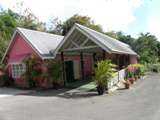
Orchid World
Barbados has the ideal climate for many tropical orchid species, and this Orchid Garden is a paradise for those who have fallen under the spell of these alluring plants. Whether you are a fan of terrestrial orchid species or the epiphytic plants that live on trees and rocks, this garden has it all. Do remember, therefore, to look up as well as down during your visit!. There is a particularly fine collection of Vanda orchids, which are among the most sought-after species for orchid collectors all over the world. Orchid World also has a number of the Caribbean native orchid species growing in the garden, incuding the Ground Orchid (see above) in both the pink and peach colour variants. Also displayed to fine effect throughout the garden are ferns, bromeliads (air plants), palms and water lilies.
There are a cafe, toilets and a gift shop on site.The gift shop is particularly good and has a good stock of lovely flower prints and other flowery gifts.

Flower Forest
This lovely garden is located at the Richmond Plantation in the Parish of St. Joseph, which has some of the most attractive scenery on the island of Barbados. The reserve covers an area of 53 acres and has numerous paths, some of which are steep and lead to magnificent views across the island. Many of the plants in the garden are labeled, which is most helpful if you are trying to identify species to try in your own garden back home. Throughout the garden the understory includes a lot of native Caribbean wildflowers, which in many cases are as beautiful as their cultivated neighbours.
There are a cafe, toilets and a gift shop on site.
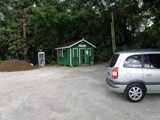
Welchman Hall Gully
The information handout at Welchman Hall Gully is predominantly about the plants, trees and shrubs found there, but this site is interesting from both a geological and an historical point of view, too. The gully is actually a collapsed cave system, and in parts feels more like a walk through caves than a valley due to the steep and rugged sides.
The Gully once formed part of a plantation owned by a Welshman, General William Asygell Williams, hence the name. During his ownership it was planted, in parts, as an orchard and a Nutmeg Grove, and if you look carefully under the Nutmeg trees you will find nutmegs on the ground still encased in their outer scarlet 'web', the latter being used as a spice in its own right - Mace. The lower reaches of the gully are still home to some of the native plants of Barbados which have all but disappeared in other parts of the island due to the cultivation of sugar cane and bananas. There is a long term plan to reintroduce more of the native plants to the reserve. Welchman Hall Gully is a most interesting and enjoyable place to visit.
There is a toilet on site and you can purchase cold drinks and ice creams at the entrance.
Some great places to eat...
There are numerous cafes and bars where you can enjoy breakfast or lunch, and some really excellent restaurants.
Writing a bad review for a restaurant in Barbados means first finding a bad restaurant! Maybe we were lucky but we didn't have a single unsatisfactory meal during our entire stay. Two restaurants in Holetown that stand out, and are at opposite ends of the cost scale, are Just Grillin' and the Beach House Bar and Restaurant. Just Grillin' is a casual diner-type restaurant that serves excellent platters of Carribean-style food such as Jerk Chicken, Grilled Shrimp or Catch of the Day and really great hamburgers. For around Bajan $60 (£20) per head you can have a really good meal with wine or beer.
The Beach House Bar and Restaurant has a fabulous oceanside setting and serves food of the highest standard both in terms of quality and presentation. A three-course meal for two with a 'modest' bottle of wine costs about Bajan $300 (£100). Many London restaurants would be pushed to serve something of a similar quality for the same price. Wine is expensive in Barbados but you have to remember that it is all imported from America or Europe - along with almost everything else you can think of!
If you like Italian food Spago's in Holetown is also an excellent choice, and they also have another restaurant in one of the close-by resorts. It falls roughly midway between the other two in price terms and serves the best pizzas we have ever eaten anywhere!
For a special treat take a day out on the east coast for a walk around the lovely Andromeda Botanic Gardens, either before or after lunch at the Atlantis Hotel in Bathsheba. The dining room must be one of the most beautiful in the world and consists of a large balcony overlooking the Atlantic Ocean. The food at this hotel, which is one of the first to have been built in Barbados, is also top class. It is echoed in their other restaurant on the west coast, Fishpot.
Top of page...